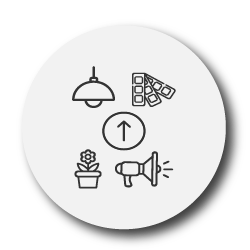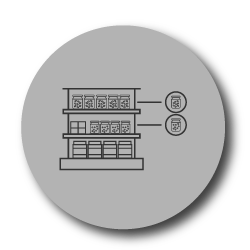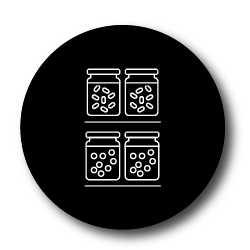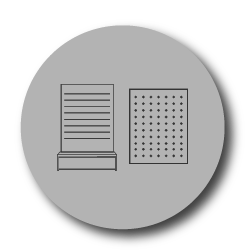
If you manage one or more pharmacy stores, space planning is critical. That's not only because it can help you to improve your in-store shopping experiences. Or, assist you to better your monthly sales and profits. Space planning is essential because when approached correctly, it can help you to offer the right products at the right time and the right price.
If you can do that, and consistently so, you can experience long-term success. Of course, when it comes to space planning for pharmacy stores, there are many opportunities that you should consider. Especially if you use specialised software.
That's what you'll find below. And it doesn't matter if you currently use space planning software or not. In truth, some of the below opportunities don’t require software.

Opportunity: Improve your atmospherics
While the first opportunity is not strictly space planning, it does influence the overall shopping experience. It also has a direct impact on how you set up your store, which does affect your space planning efforts.
That is your store atmospherics. Atmospherics refers to the atmosphere or mood that you create in your store by way of introducing various elements and effects. These include the scent of your store, the lighting, colour scheme, layout, sound and visual stimulus.
So how can you make the most of your store atmospherics as a pharmacy retailer?
If we take lighting as an example, it’s worth investing in cold white lighting for the effect. It gives your customers the impression of a clean, clinical environment, which is what you’d expect as you walk into a pharmacy. To gain a competitive advantage, you could also consider incorporating other colours that give your customers the impression of health and natural products.
If you consider colour, white is the obvious choice since it’s a colour worn by doctors and nurses. It’s also associated with professionalism and expertise and hygiene. For sound, again, you’d want to match it to the expectations of your customers. For pharmacy stores, it’s better to use music to create a calm and relaxed atmosphere.
As for the consequences of ignoring your atmospherics, that’s simple: it can lead you to lose customers. Be that gradual or immediate is not the point. Atmospherics plays a vital role in the overall customer experience and if you interrupt that, it’ll harm your brand.
If shoppers have an unpleasant experience because the temperature is too hot, the music just that bit too loud or the lighting is too bright, the chances of them returning decreases. It’ll decrease even more if your direct competitor has placed a focus on its atmospherics.

Opportunity: Build data-driven planograms for each category
Building planograms, let alone data-driven ones is an opportunity that you shouldn’t miss out on. We’ll cover the consequences of not building data-driven planograms later on. For now, it’s worth pointing out the aim of any planogram: to increase your sales and profitability.
That aside, how should you build them?
One approach for pharmacy stores is to build them based on days of supply. Since your medication and supplements often have a shorter shelf sell-by-date, if they stand too long on the shelf, you run the risk of having to throw them away.
Of course, if you were to build data-driven planograms according to an average days of supply (DOS), you should always take the unit size of the products in your different categories into account.
Of course, there are instances and opportunities where you can build a planogram on other instances other than days of supply. For example, you could consider building planograms on % Sales or % Sales and Units. The result is that it allows you to give more space to a product which could potentially bring in more sales than units.
Also, by taking that into account, you can merchandise your top contributors at eye-level. That, in turn, can increase your sales units and profits.
And the consequences? You can notice the difference between a pharmacy store implementing data-driven planograms and another that isn’t. For one, the flows will be all over the place. The stock on your shelves will be out of proportion to your requirements, thereby not meeting the needs of your customers. You’ll have either too much stock or too little.
You’ll likely fail to present categories to customers in the way they would look to purchase products. Any replenishment exercises will be tedious as you’ll struggle to balance out your days of supply across your products. And don’t forget the issue of having your capital tied up in your inventory.

Opportunity: Choose the right product assortment
There are multiple factors when it comes to choosing and establishing a product assortment for your store.
For one, it’s critical to establish the role you want a category to play. Do you want to give a category a Destination, Routine, Convenience or Seasonal role? Doing so allows you to establish the width and depth of your assortment.
Let’s use the Baby Formula category as an example. You could give it a Destination role. In that case, you’d select a wide and deep assortment. That includes sub-categories such as premium, economy and specialised formulas. Then within each of the sub-categories, you could also consider offering a deep assortment to further entrench that role.
For those categories that you may stock for upselling your customer - taking on a convenience role - you could consider both a narrower and shallower assortment.
You could also take your range caps and the actual size of your store into account before establishing your range. There is also your target market and their specific demographics that’ll influence your range too.
What’s more, you could also look at market data provided by your suppliers to compare your assortment with that of your competitors and the greater market. Can you offer a product that will bring more customers to your store? If you can, and the data backs it up, then it’s worth stocking.
When it comes to the consequences of getting your assortment wrong, let’s consider mismatching the role of a category with its strategy. And we’ll use the Male Grooming category, which could follow a transaction building strategy, as an example. This strategy aims to convince your customers to add to their baskets by offering a range of products that complement others.
If your pharmacy store only offers face washes in the Men’s Skin Care assortment, there is no opportunity to upsell your customers. They can’t increase their basket size. However, if you tweaked your assortment to offer face wash, scrubs, moisturisers and aftershave, you have every opportunity of upselling them.

Opportunity: Use retail fixtures that present your products best
The shelving you choose for your store has a larger impact on your overall success than you may give it credit. You’d only need to read this article for further evidence.
As for pharmacy stores, ideal retail fixtures are gondolas with adjustable shelving. Yes, this shelving is functional but in an environment such as a pharmacy, where it’s best to present your products with as little fuss as possible, it’s necessary.
Adjustable shelving allows you to add more shelves to a gondola if and when needed. It also allows you to increase the shelf space for a category.
You do, of course, need to consider the size of the products in each category. For example, your Sports Protein tubs are large and bulky whereas your vitamin bottles are small. In these instances, to balance out your days of supply, you may need to design wide and deep shelves to increase the number of facings and present the right amount of product according to customer needs.
For specific categories, you could design or use other shelving and display cases. For example, if you stock perfumes and breakable bottles, you could look at placing them in locked glass cabinets behind a counter or on a wall. Not only does that allow you to keep them safe from unnecessary breakages, but it can also prevent theft.
That said, the consequences can prove costly. By its nature, gondola shelving requires a lot of space, so you do need to order them correctly. By not choosing the correct amount, you’ll struggle to optimise your floor space.
The flow of your store is also determined by where you place your gondolas. If you place them on your floor without a plan or strategy, you’ll make the shopping experience chaotic and unpleasant. Consider your overall floor space available and position your gondolas accordingly while placing product categories in a logical manner and aiming to expose your shoppers to as many products as possible.
Meanwhile, by using adaptable shelving, you need to be aware that you could decrease the number of products able to fit on a gondola, which could lead you to require more gondolas. The result is you might find your floor space cluttered and you could increase the possibility of floor congestion.

Opportunity: Design a floor plan that encourages customers to buy more
Alongside the planograms you build and the fixtures you choose to display your products, you also need to consider your floor plan. More specifically, you need to design one that encourages your customer to fill their baskets.
For pharmacy stores, if you want to design such a floor plan, you must determine what each category or department means to your business. That includes identifying your top contributing categories - the Destination categories as well as the flow of the categories throughout your store. It also determines its location in your store.
Let’s consider your Vitamins, Medical and Sports Nutrition categories. Your Sports Nutrition category isn’t the fastest mover when you compare it to other departments. It’s a select group of people who will come into your store to buy these products. Thus, there is no need to keep this category in the back of your store and make your customers walk all the way to get it.
It makes more sense to place your Vitamins or your Medical category in the back. Then, as your everyday shopper who comes in for products in those categories, they’re more likely to buy other products along the way.
Let’s say, a mother comes in needing cough medicine for their baby. As they pass other categories to pick up the medicine, they walk through the Baby department and they realise they need diapers. And you have diapers on a special, which will further motivate the purchase.
When setting out your floor plan, it’s also advisable to place complementary categories next to each other. For example, you could place your Health Foods category next to your Sports Nutrition category. If you don’t, the obvious consequence would be confusion and frustration.
Why would you place two unrelated categories next to each other? That would make no sense to any customer who walks into your store. Then there is the problem of floor congestion, which we’ve already briefly mentioned.
That occurs when you place too many top contributing categories next to each other. By placing all of your Destination categories close to each other, you’ll have too many shoppers in one area. By spreading out your categories, you can encourage shoppers to stay longer and add to their baskets.
Conclusion
DotActiv offers category management solutions for pharmacy retailers. Need to create powerful data-driven assortments and space plans that meet the needs of anyone who walks into your pharmacy stores? Click here to find out more or here to get a 14-day trial of any edition of DotActiv software.


